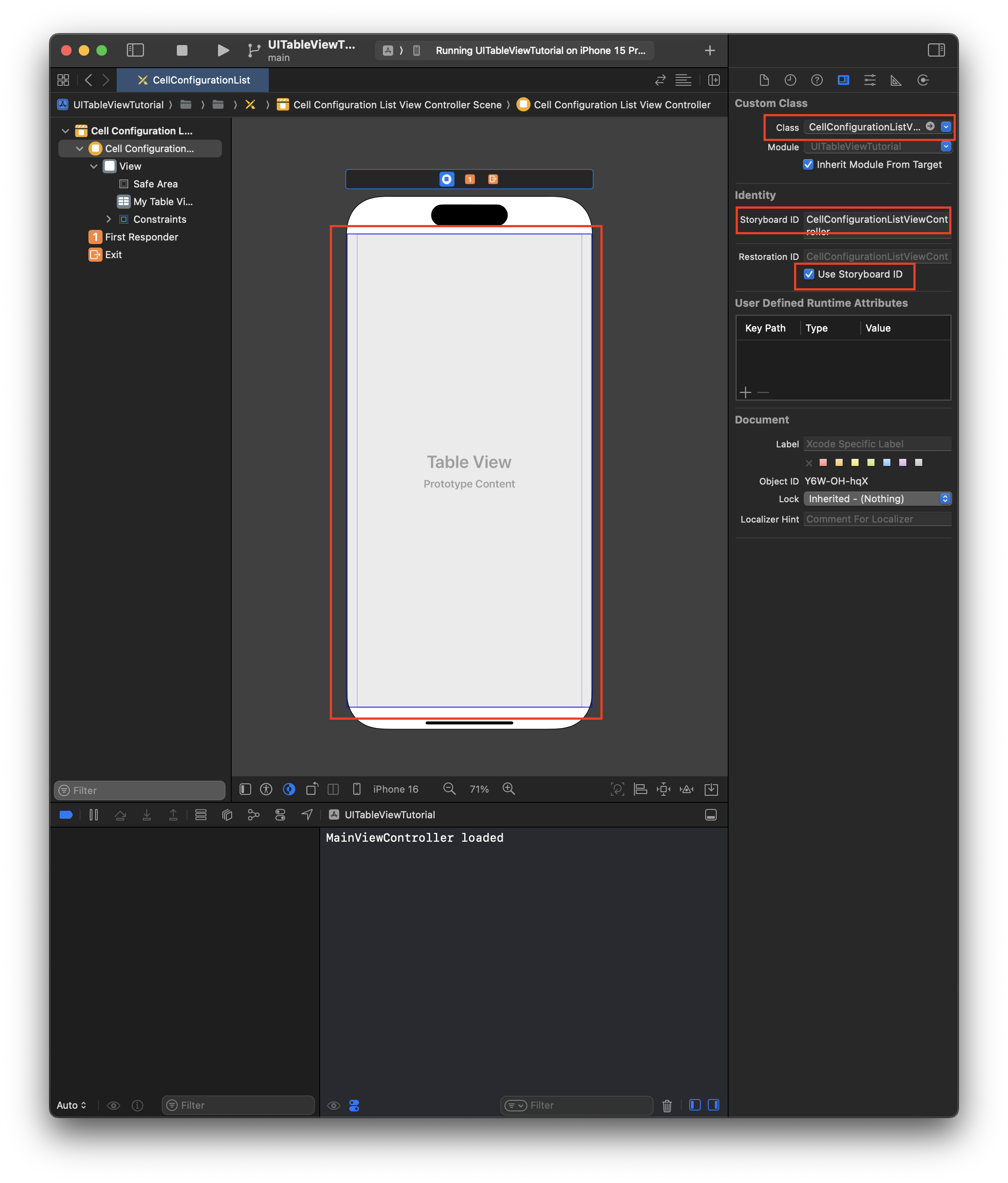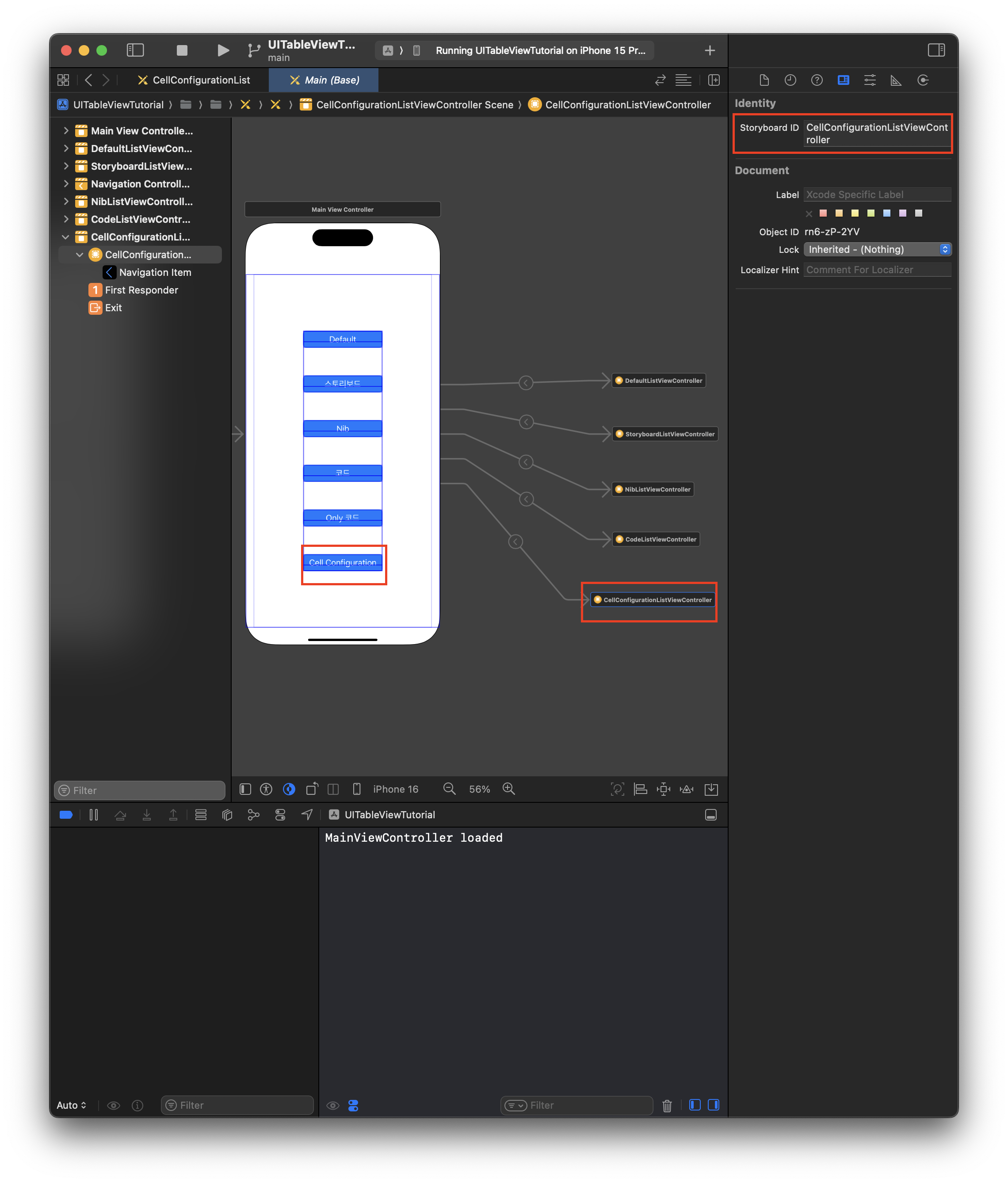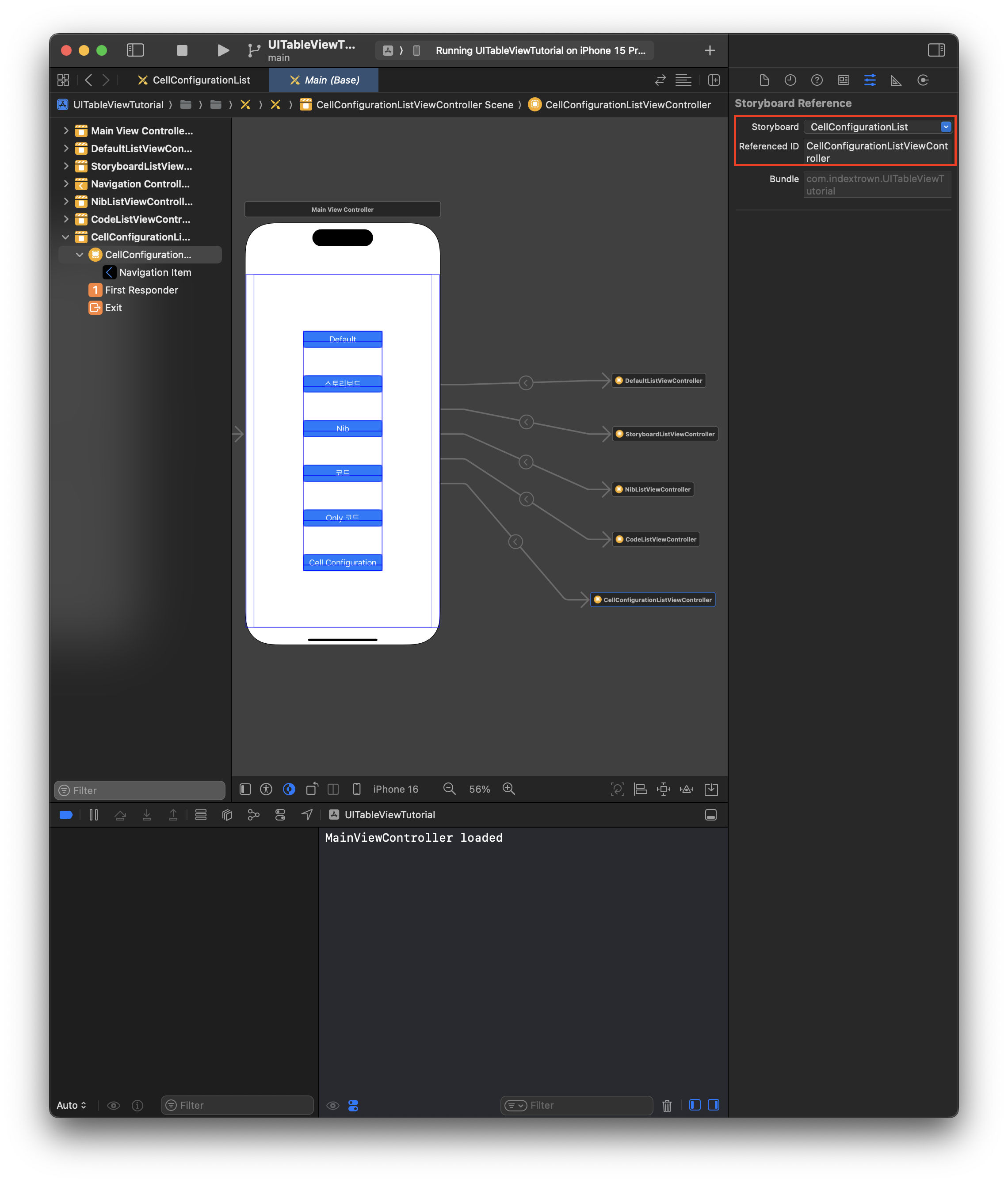[TableView] 6. Cell Configuration
Cell Configuration 알아보기
Cell Configuration은 iOS 14+부터 도입된 기능으로, 셀의 UI 구성과 데이터 설정을 보다 선언적으로 처리할 수 있도록 도와준다.
기존에는 셀마다 IBOutlet을 연결하거나, cell.textLabel.text = ... 방식으로 직접 설정했지만,
Cell Configuration은 UI와 데이터를 분리하고 설정 구조체를 통해 셀 내부 뷰를 생성 및 업데이트하는 구조다.
화면 구성 예시

- 테이블뷰를 스토리보드에서 추가하고, 상하좌우 제약을 0으로 설정한다


Storyboard ID는CellConfigurationListViewController로 지정Reference ID도 동일하게 맞춰야 코드에서 호출 가능
구성
Cell Configuration을 구성하는 핵심 요소는 다음과 같다:
| 요소 | 설명 |
|---|---|
UIContentConfiguration |
데이터 설정을 위한 구조체 역할 (예: MyCellConfiguration) |
UIContentView |
실제 UI를 그리는 뷰 (예: CellConfigurationView) |
UITableViewCell |
시스템이 자동으로 UIContentView를 삽입해주는 셀 컨테이너 (CellConfigTableViewCell) |
1. MyCellConfiguration.swift
struct MyCellConfiguration: UIContentConfiguration, Hashable {
var title: String = ""
var body: String = ""
func makeContentView() -> UIView & UIContentView {
return CellConfigurationView(config: self)
}
func updated(for state: UIConfigurationState) -> MyCellConfiguration {
var updated = self
if let state = state as? UICellConfigurationState, state.isSelected {
updated.title = "선택됨: " + updated.title
}
return updated
}
}
- 데이터(title, body)를 담고 있고, 상태(state)에 따라 동적으로 내용도 바꿀 수 있다.
makeContentView()를 통해 실제 UIContentView (CellConfigurationView) 생성
2. CellConfigurationView.swift
class CellConfigurationView: UIView, UIContentView {
var configuration: UIContentConfiguration {
get { customConfiguration }
set {
if let config = newValue as? MyCellConfiguration {
applyConfig(config)
}
}
}
init(config: MyCellConfiguration) {
super.init(frame: .zero)
configureUI()
applyConfig(config)
}
fileprivate func applyConfig(_ config: MyCellConfiguration) {
self.customConfiguration = config
titleLabel.text = config.title
bodyLabel.text = config.body
}
}
UIView이자UIContentView를 채택- 외부에서 전달받은
MyCellConfiguration을 적용해서UILabel에 반영 - 내부적으로
titleLabel,bodyLabel을 AutoLayout으로 배치
3. CellConfigTableViewCell.swift
class CellConfigTableViewCell: UITableViewCell {
var title: String = "" {
didSet { setNeedsUpdateConfiguration() }
}
var body: String = "" {
didSet { setNeedsUpdateConfiguration() }
}
override func updateConfiguration(using state: UICellConfigurationState) {
var config = MyCellConfiguration().updated(for: state)
config.title = title
config.body = body
self.contentConfiguration = config
}
}
setNeedsUpdateConfiguration()호출 시 시스템이updateConfiguration(using:)을 호출title,body를 가지고MyCellConfiguration을 만든 뒤contentConfiguration에 설정- 시스템은 이 설정을 보고 자동으로
CellConfigurationView를 생성 및 삽입
4. CellConfigurationListViewController.swift
func tableView(_ tableView: UITableView, cellForRowAt indexPath: IndexPath) -> UITableViewCell {
guard let cell = tableView.dequeueReusableCell(withIdentifier: "CellConfigTableViewCell", for: indexPath) as? CellConfigTableViewCell else {
return UITableViewCell()
}
let cellData = dummySections[indexPath.section].rows[indexPath.row]
cell.title = cellData.title
cell.body = cellData.body
return cell
}
- 더미 데이터를 불러와
title,body만 할당하면 자동으로 UI가 구성된다 - 직접적으로
UILabel에 접근하거나cell.subviews를 조작하지 않아도 된다
전체 예제 코드
1. MyCellConfiguration.swift
import UIKit
// 커스텀 셀에 대한 설정
struct MyCellConfiguration: UIContentConfiguration, Hashable {
var title: String = ""
var body: String = ""
// 보여줄 화면
// UIView이면서 UIContentView인 애를 반화내라
func makeContentView() -> any UIView & UIContentView {
return CellConfigurationView(config: self)
}
/// 셀 상태가 변경되면 발동
/// - Parameter state: 셀 상태
/// - Returns: 셀 설정 자체
func updated(for state: any UIConfigurationState) -> MyCellConfiguration {
if let state = state as? UICellConfigurationState {
var updatedConfig = self
if state.isSelected {
updatedConfig.title = "선택됨: " + updatedConfig.title
}
return updatedConfig
}
return self
}
}
2. CellConfigurationView.swift
import UIKit
// 뷰 안에 컨텐츠 Config를 가지고 있는 뷰
class CellConfigurationView: UIView, UIContentView {
// 여러 데이터를 가진 덩어리
fileprivate var customConfiguration: MyCellConfiguration!
// 데이터와 UI를 연결
fileprivate func applyConfigAndChangeUI(_ newConfiguration: MyCellConfiguration) {
self.customConfiguration = newConfiguration
titleLabel.text = newConfiguration.title
bodyLabel.text = newConfiguration.body
}
var configuration: UIContentConfiguration {
get { customConfiguration }
set {
if let newConfiguration = newValue as? MyCellConfiguration {
applyConfigAndChangeUI(newConfiguration)
}
}
}
init(config: MyCellConfiguration) {
super.init(frame: .zero)
configureUI()
applyConfigAndChangeUI(config)
}
lazy var titleLabel: UILabel = {
let label = UILabel()
label.translatesAutoresizingMaskIntoConstraints = false
label.text = "타이틀 라벨타이틀 라벨타이틀 라벨타이틀 라벨타이틀 라벨"
label.numberOfLines = 1
label.textColor = .white
label.font = UIFont.systemFont(ofSize: 14, weight: .bold)
return label
}()
lazy var bodyLabel: UILabel = {
let label = UILabel()
label.translatesAutoresizingMaskIntoConstraints = false
label.text = "바디 라벨바디 라벨바디 라벨바디 라벨바디 라벨바디 라벨바디 라벨바디 라벨바디 라벨바디 라벨바디 라벨바디 라벨바디 라벨바디 라벨바디 라벨바디 라벨바디 라벨바디 라벨바디 라벨바디 라벨바디 라벨바디 라벨바디 라벨바디 라벨바디 라벨바디 라벨바디 라벨"
label.numberOfLines = 0
label.textColor = .white
label.font = UIFont.systemFont(ofSize: 12, weight: .regular)
return label
}()
fileprivate func configureUI() {
self.backgroundColor = .systemBlue
// 타이틀 라벨 설정
self.addSubview(self.titleLabel)
NSLayoutConstraint.activate([
titleLabel.topAnchor.constraint(equalTo: self.topAnchor, constant: 10),
titleLabel.leadingAnchor.constraint(equalTo: self.leadingAnchor, constant: 10),
titleLabel.trailingAnchor.constraint(equalTo: self.trailingAnchor, constant: -10),
])
// 바디 라벨 설정
self.addSubview(self.bodyLabel)
NSLayoutConstraint.activate([
bodyLabel.topAnchor.constraint(equalTo: self.titleLabel.bottomAnchor, constant: 10),
bodyLabel.leadingAnchor.constraint(equalTo: self.leadingAnchor, constant: 10),
bodyLabel.trailingAnchor.constraint(equalTo: self.trailingAnchor, constant: -10),
bodyLabel.bottomAnchor.constraint(equalTo: self.bottomAnchor, constant: -10)
])
}
required init?(coder: NSCoder) {
super.init(coder: coder)
}
override func layoutSubviews() {
super.layoutSubviews()
}
}
#if DEBUG
import SwiftUI
struct CellConfigurationView_PreviewProvider_Previews: PreviewProvider {
static var previews: some View {
CellConfigurationView(config: MyCellConfiguration(title: "오늘도 코딩", body: "바디부분")).getPreview()
.previewLayout(.fixed(width: 200, height: 100))
}
}
#endif
3. CellConfigTableViewCell.swift
import UIKit
// 기존 테이블뷰 셀은 데이터만 신경쓰면 됨
class CellConfigTableViewCell: UITableViewCell {
// 데이터 변경시 UI 변경해라
var title: String = "" {
didSet {
setNeedsUpdateConfiguration()
}
}
var body: String = "" {
didSet {
setNeedsUpdateConfiguration()
}
}
override func updateConfiguration(using state: UICellConfigurationState) {
super.updateConfiguration(using: state)
var contentConfig = MyCellConfiguration().updated(for: state)
contentConfig.title = title
contentConfig.body = body
self.contentConfiguration = contentConfig
}
override func layoutSubviews() {
super.layoutSubviews()
}
}
#if DEBUG
import SwiftUI
struct CellConfigTableViewCell_PreviewProvider_Previews: PreviewProvider {
static var previews: some View {
CodeCell().getPreview()
.previewLayout(.fixed(width: 200, height: 100))
}
}
#endif
4. CellConfigurationListViewController.swift
import UIKit
class CellConfigurationListViewController: UIViewController {
@IBOutlet weak var myTableView: UITableView!
var dummySections: [DummySection] = DummySection.getDumies(10)
override func viewDidLoad() {
configureTableView()
}
fileprivate func configureTableView() {
// CodeCell에서는 이 줄만 필요
self.myTableView.register(CellConfigTableViewCell.self, forCellReuseIdentifier: "CellConfigTableViewCell")
self.myTableView.dataSource = self
self.myTableView.delegate = self
}
}
/// UITableView의 데이터 관리 역할을 담당
extension CellConfigurationListViewController: UITableViewDataSource {
/// 섹션이 여러개일때만 사용
/// 섹션의 타이틀 설정
func tableView(_ tableView: UITableView, titleForHeaderInSection section: Int) -> String? {
return "헤더: " + dummySections[section].title
}
func tableView(_ tableView: UITableView, titleForFooterInSection section: Int) -> String? {
return "푸터: " + dummySections[section].title
}
/// 섹션이 여러개일때만 사용
/// 현재 섹션이 몇개인지
func numberOfSections(in tableView: UITableView) -> Int {
return dummySections.count
}
/// 하나의 섹션에 몇개의 rows가 있냐
func tableView(_ tableView: UITableView, numberOfRowsInSection section: Int) -> Int {
return dummySections[section].rows.count
}
/// 각 셀에 대한 내용을 구성하여 반환 -> 셀의 종류를 정하기 - 테이블뷰 셀을 만들어서 반환해라
/// - indexPath: 셀의 위치를 나타내는 인덱스 경로
/// - returns: 구성된 UITableViewCell 객체
func tableView(_ tableView: UITableView, cellForRowAt indexPath: IndexPath) -> UITableViewCell {
/// 기본 스타일의 셀 생성 (textLabel과 detailTextLabel 포함)
/// let cell = UITableViewCell(style: .subtitle, reuseIdentifier: "MyCell")
// [guard let] 방식
guard let cell = tableView.dequeueReusableCell(withIdentifier: "CellConfigTableViewCell", for: indexPath) as? CellConfigTableViewCell else {
return UITableViewCell()
}
let sectionData: DummySection = dummySections[indexPath.section]
let cellData: DummyData = sectionData.rows[indexPath.row]
/// 셀의 주 텍스트를 더미 데이터에서 가져오기
// cell.titleLabel.text = cellData.title
/// 셀의 서브 타이틀 설정
// cell.bodyLabel.text = cellData.body
//cell.detailTextLabel?.numberOfLines = 0
// 여기서는 UI에 접근하는게 아니라 Cell이 가지고 있는 멤버변수 데이터 자체에 접근
cell.title = cellData.title
cell.body = cellData.body
return cell
}
}
/// 이벤트 관련 부분 - 셀 선택 등 사용자 인터랙션(이벤트) 관련 처리
extension CellConfigurationListViewController: UITableViewDelegate {
/// 사용자가 특정 셀을 선택했을 때 호출되는 메서드
/// - Parameters:
/// - tableView: 이벤트가 발생한 테이블 뷰
/// - indexPath: 선택된 셀의 위치
func tableView(_ tableView: UITableView, didSelectRowAt indexPath: IndexPath) {
print(#fileID, #function, #line, "- indexPath: \(indexPath.row)")
}
}
Leave a comment